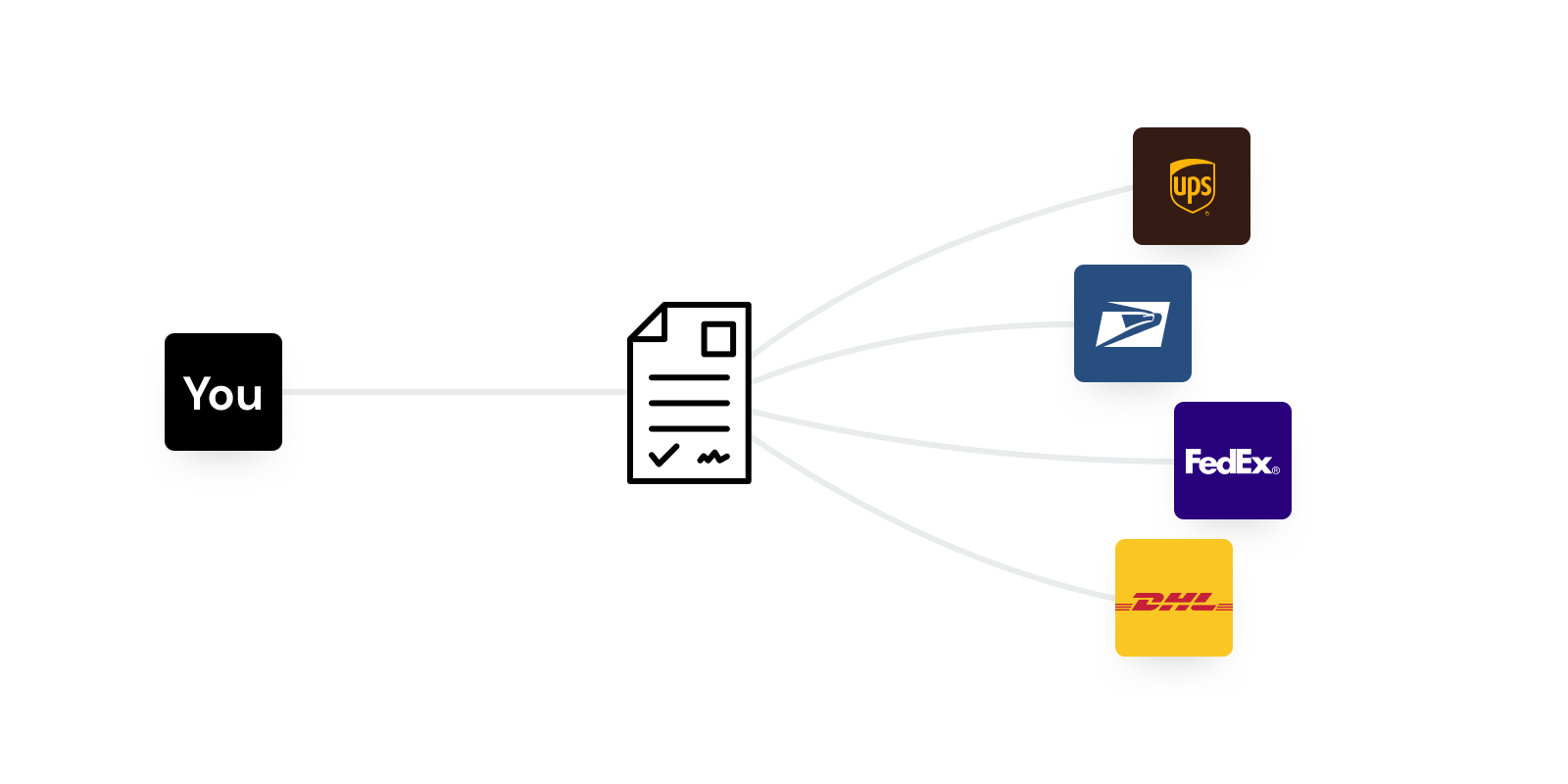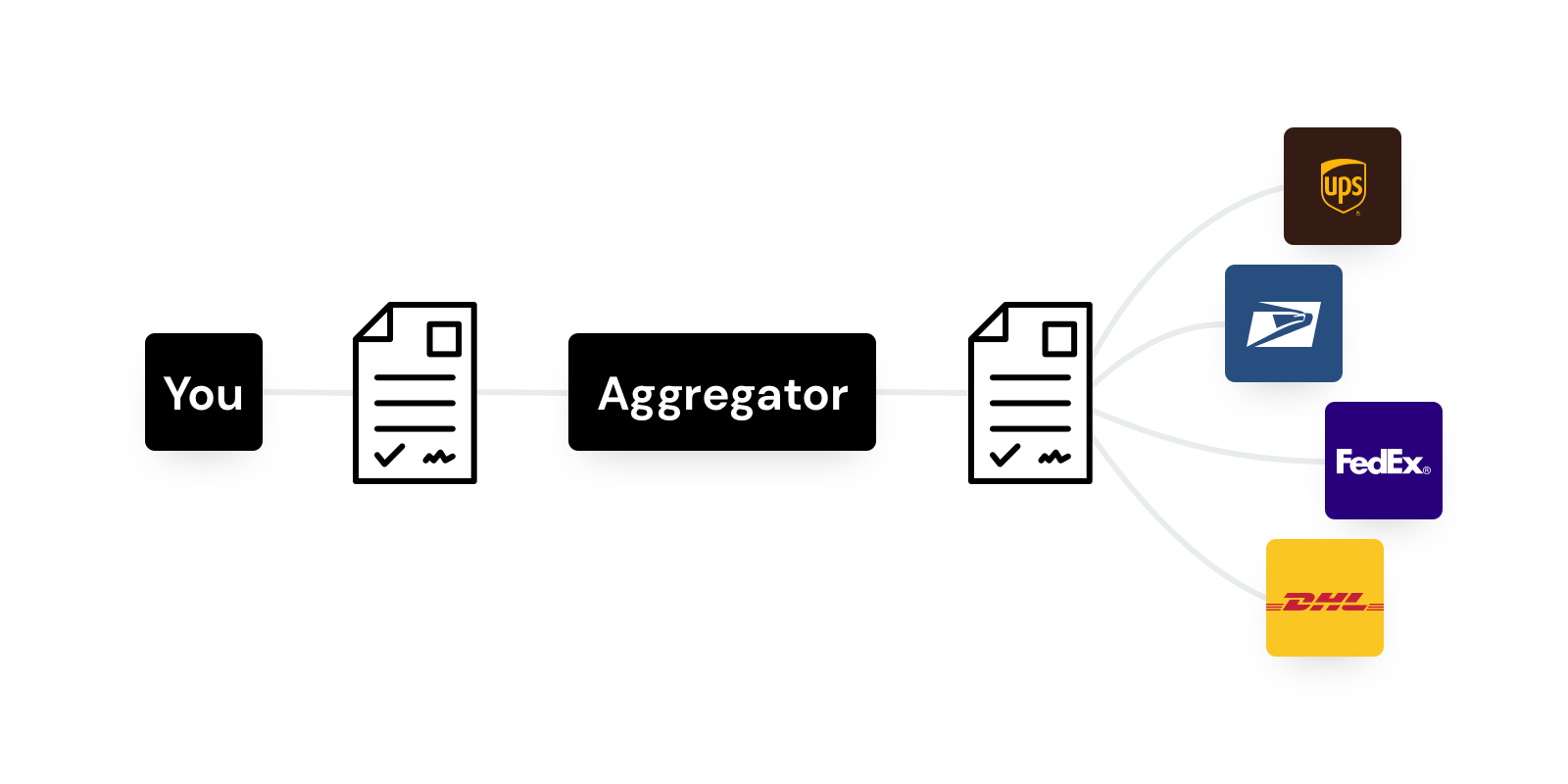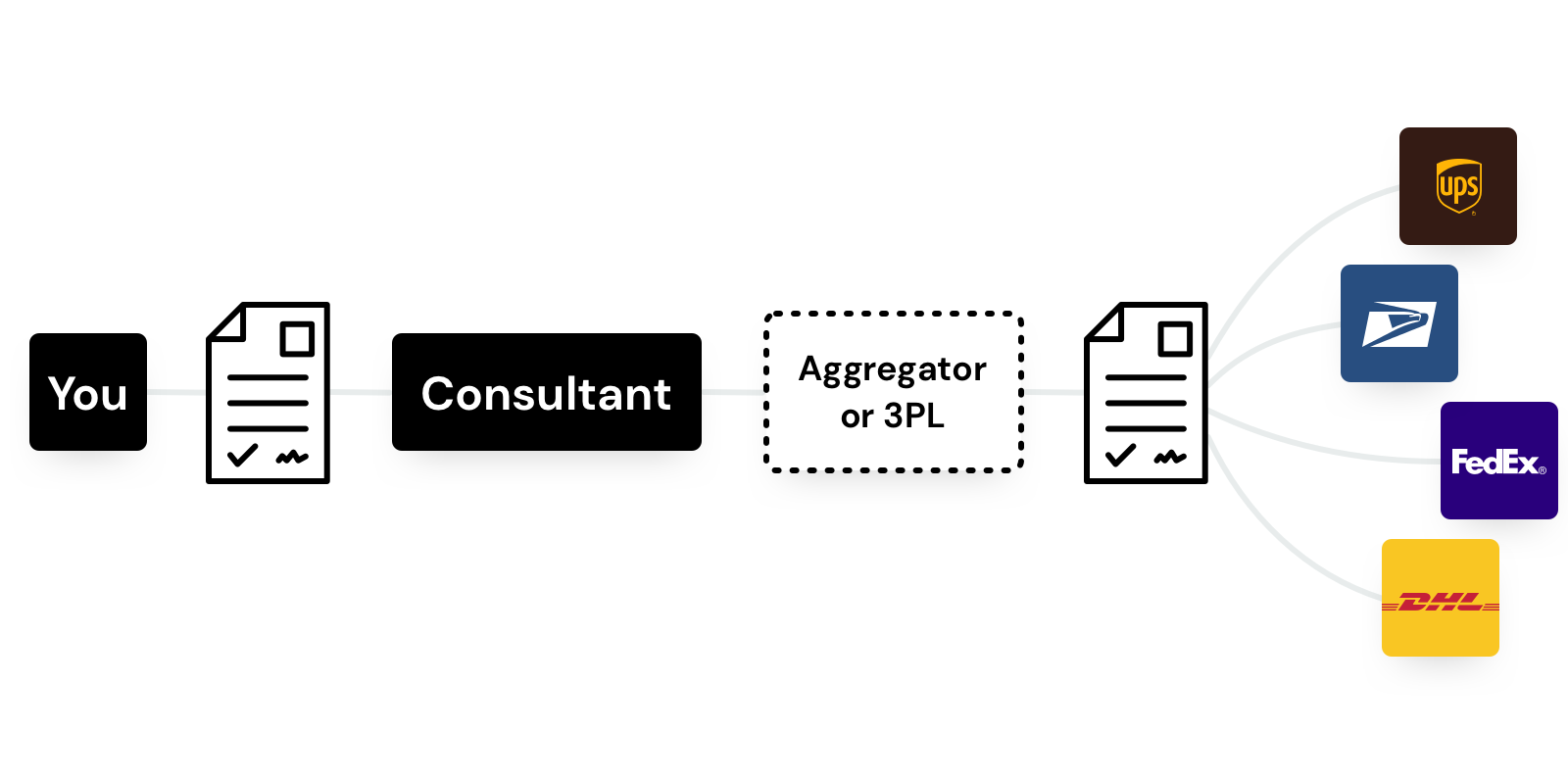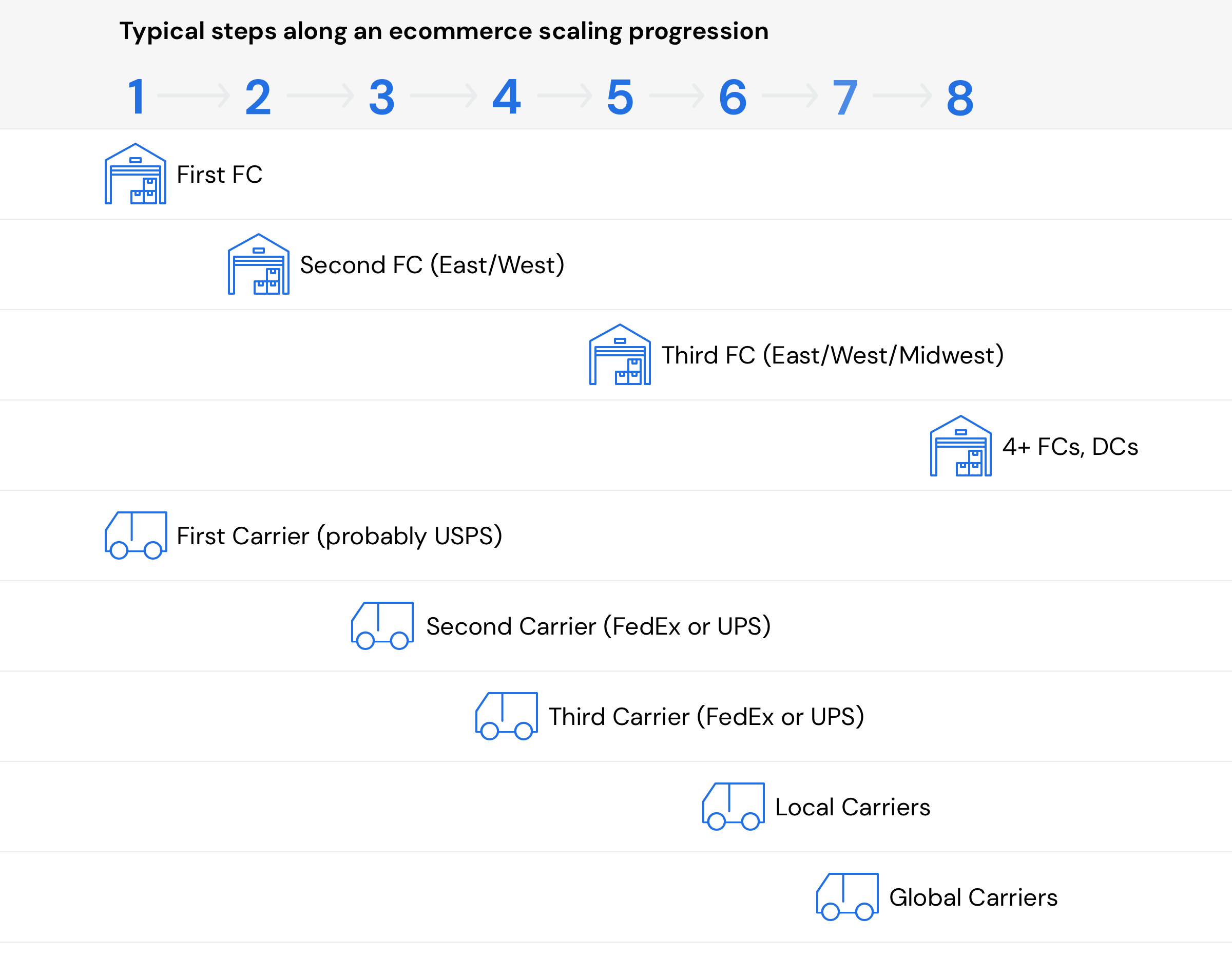
Adding a New Carrier
Who is this for?
Read this if you are adding a new outbound shipping carrier to your distribution mix, whether you are a startup founder adding your first carrier, or an industry veteran adding your tenth. The details below provide value all the same.
Summary
All ecommerce companies by rule need to deliver orders to customers. While some pick-up-from-store and other hybrid options exist, the point of ecommerce is to receive digital orders and deliver physical goods in the hands of customers.
As a result, adding outbound shipping carriers to your operations stack is a near-universal task. But it is complicated.
This play walks you through considerations and strategies when adding a new carrier.
Overview
To best understand the scope of the problem, apply some good ol' fashioned Aristotle rhetoric. You are trying to solve for:
- Why to add a new carrier
- When to add
- What to add
- Where to add
- Who to add
- and How to add
The complications come with the interconnectedness of decisions. Where you decide to add a new carrier could totally impact who to add, for example.
Keep in mind all these problems are upstream from the challenge of actually negotiating with the carrier you are adding. We cover the negotiating process in a separate article. For the purposes of this play, we are focused on the strategy that goes into picking a carrier, and then the process by which you go about adding the carrier to your mix.
Let's walk through in full detail.
The Plays
Lay of the land
It should first be noted all the different ways you can engage with a carrier option. There are many ways, but let's focus on the five most typical.
Direct relationship with the carrier
The most common method is to establish a business account directly with a carrier. You own the contract, which has its own definitions and rates unique to you.

Pros:
- At scale, this method provides the best value. There is a reason behemoths like Amazon or Walmart, or even mid-size growing DTC companies, go this route. You will always get the best rates this way.
- As a company scales, building internal muscle memory around how to negotiate, secure, and manage direct relationships with carriers will become critical to securing the best possible rates and service level agreements (SLAs).
Cons:
- The prospect of negotiating, securing, and managing a direct relationship is really complex! It's probably why you are reading this article. Sometimes, the complexity isn't worth the rate you'll get, in particular as a smaller organization.
- Compared to other options, you might not have the ability to get out of a bad contract. For example, maybe you secure a 2-year deal with FedEx, where rates from an aggregator like ShipStation can be an as-is transaction with no lock-in.
Aggregators
Many companies secure a rate with a carrier then resell that rate to customers. By being an aggregator of demand across many customers, the aggregator can establish leverage with a carrier to get a low rate. The concept functions a lot like a Group Purchasing Organization (GPO) in healthcare.
Some companies got their start strictly providing this service. ShipStation is probably the largest example, as they tout the lowest possible negotiated USPS rates other than the US government itself. But lately, aggregation of rates has become a single feature among many and is commonly found as an option provided by SaaS products offering many additional features, such as tracking APIs.

Pros:
- The simplest way to get started. Less complexity to integrate their offerings into your ops stack.
- Many modern aggregators offer easy-to-use APIs. (While many older aggregators do not. Buyer beware!)
Cons:
- Aggregators negotiate with carriers in a standardized fashion. No two ecommerce companies are alike, especially when it comes to shipping profiles. Consequently, you can be sure that an aggregator isn't negotiating for rates that are perfectly optimized for your type of shipping profile. This is a simplified explanation to underscore how you will always obtain the best rates going direct to the carriers.
- These businesses usually make money by reselling their rates with a markup. You will pay a margin on every label printed, which can add up to a large margin-eating expense over time.
3PLs
Your 3PL can offer outbound shipping services in addition to base services like warehousing and fulfillment. Their model is similar to the aggregators above, but localized to the individual 3PL. Since the 3PL is usually servicing many customers per location, the 3PL will establish a contracted rate with a carrier and resell those rates to all customers.

Pros:
- Similar to aggregators, this method minimizes complexity to get started.
- Since the rates resold are with carriers who the 3PL has an established relationship, you can usually be sure that 3PL-to-carrier handoff will be reliable.
- "One throat to choke" can be useful if any issues happen. It can be advantageous to consolidate several SLAs across the supply chain (inbound ➜ warehousing ➜ fulfillment ➜ outbound) with a single vendor, the 3PL.
- Companies at a certain scale will benefit from adding local carriers to the mix. Often, your 3PL partners can be the fastest way to establish a relationship with a reliable local carrier.
Cons:
- Shipping services are another lever for 3PLs to hide additional markup. It can be hard to identify where you are getting gouged from the 3PL with the more services you add.
- Like aggregators, you are sharing in margin. It's not the most cost-effective method.
- You are limited to whatever carriers/methods they have available.
Consultants
It's possible to find consultants who specialize in selecting and negotiating carrier contracts on your behalf. Sometimes they will simply augment your team and you'll own the resulting contract. Sometimes the consultancy itself will own the contract. While the former could be be somewhat categorized as a direct relationship above, the latter can be more like working with an aggregator.

Pros:
- Allows you to hand off all the complexity of working with a carrier while still getting many of the benefits of directly working with a carrier, such as having the contract optimized for your shipping profile.
- If the consultant is experienced, you can de-risk mistakes, such as picking the wrong carrier for your needs, or agreeing to a poorly negotiated contract.
Cons:
- The process is often a black box to you, which means you might not be sure you are getting the best rates.
- Lose the ability to build this muscle yourself.
- These consultancies typically charge based on amount saved. It's not uncommon for them to take a 30%-50% cut of the savings. Depending on how it all works out, it might end up being worse margin impact than having gone with a 3PL or aggregator!
SaaS Platforms
Many ecommerce companies are incorporating more software platforms into their ops stack. The most famous are storefronts like Shopify, but there are niche categories like label printing software solutions such as EasyShip. In any case, the software vendor acts much like an aggregator by securing rates then reselling them to customers. Indeed, aggregators are increasingly expanding to SaaS-like product offerings while SaaS companies are increasingly offering shipping rates as part of their platforms.

Pros:
- Potentially even easier to get quickly get started than aggregators.
- Often integrated with the other platform service offerings.
Cons:
- Much like aggregators above, the rates secured won't be entirely optimized for your given profile, so you can be sure they aren't the most cost-effective.
- Fundamental economic principles like supply/demand and market share dictate important aspects like leverage. Subsequently, really large SaaS platforms like Shopify can achieve cheaper rates like an aggregator. But on the flip side, smaller software companies without much of a customer base might not be able to negotiate as good of rates, and you should look elsewhere. A good reminder to do your homework and compare.
Adding your first carrier vs. an additional carrier
There are differences between adding your first carrier versus additional carriers.
First, a business rule of thumb.
For both startups or new initiatives at an enterprise, it's wise to be optimized towards revenue instead of profit, so to speak. So often is the case that getting product out the door, or trying a new idea or program, is more critical than optimizing cost structures. The urgent existential threat is to prove the model or idea to yourself, investors, or management.

(Image from XKCD)
As far as ecommerce goes, adding your first carrier should be all about speed, operational simplicity, and enablement. Optimizing cost can come at a later date. Proceed with selecting your first carrier knowing that cost-per-unit will be higher than it should be.
With this in mind, fixed rates from aggregators are a great fit. Onboarding is quick and complexity is reduced. Or, if you prefer to go directly to a carrier, a simple deal structure at higher rates is usually better than a complicated deal structure with slight savings.
As your company scales revenue and operational complexity, renegotiating with your first carrier gradually becomes a priority. Similarly, adding new carriers to the mix becomes an exercise of cost structure optimization over simplicity and speed.
If you are just getting started, we suggest engaging with a carrier through a 3PL, aggregator, or SaaS platform.
If you are diversifying carriers, then the rubric for addition becomes considerably more complex, and going direct is probably the best route, which we'll discuss below.
How to pick additional carriers
Using two or more carriers creates speciality, which affords (a) cost saving opportunities through arbitrage, which becomes the number one way to reduce outbound shipping costs; or (b) additional delivery options for customers which can increase conversion and loyalty.
For example, if you only have a contract with USPS, then everything ships USPS. But if you add UPS, FedEx, and local carriers, then real-time decisions between options in order to find the best speed at lowest cost becomes the goal.
Knowing who, what, and where to pick depends on your shipping profile.
To recap, a shipping profile is the collection of attributes and properties which define what you ship, to where, when, and how often.
It starts by annotating package properties, like dimensions and weight (or dim-weight). Take that and overlay zone distributions and volume to get a feel for patterns. Then compare that to rates and other charges to understand cost efficiencies and inefficiencies.
For example, an outcome from the exercise could be, "Over 60% of our orders are shipped in under 1 lb boxes to Zones 1-4 from our East/West FC locations, so if we can secure a new carrier with a specialized rate for that profile, we could save several percentage points in our annual outbound shipping spend."
The opportunities for specialization go as far as you take them. You can start to segment based on:
- Geography — e.g., Lower 48 vs. Hawaii/Alaska, East vs. West, International
- Zones — e.g., Zones 1-2 versus Zones 5-8 long-hauls
- Speed of delivery — e.g., Carrier ABC for next-day shipping and Carrier XYZ for long but cheap shipping
- Package dim-weights — e.g., Carrier ABC gets all orders under 1 lb while Carrier XYZ gets everything else
- Surcharges — e.g., Carrier ABC has no fees for "Business" delivery, so that carrier gets all orders denoted as office deliveries because Carrier XYZ has a surcharge on that. Or vice-versa for "Residential". There are dozens of surcharges, and there might be opportunity for optimization along a specific surcharge if it's a frequent enough situation for your profile.
- Size of load — e.g., an LTL or FTL need unique to your profile
- Business model — e.g., if you are a subscription-based model, Carrier ABC might handle the first delivery to a customer with a 2-day method, while all subsequent deliveries might go through Carrier XYZ at the slowest and cheapest method possible since you can pre-plan fulfillment in advance.
Working with drop shippers
In most cases, you as the seller will have a relationship with a carrier via one of the mechanisms discussed earlier. A drop shipping business model shares similarities to working with a 3PL. The drop shipper is a partner to which you push orders. Therefore, the drop shipper must work with the carrier you pick and labels you push to them.
Sometimes, the relationship might be like working with a 3PL who has established carrier contracts already, and you simply push the order to the drop shipper who then uses their own system to generate a shipping label and ship the package.
In both cases, sophistication becomes limiting factor. Availability of carrier or method type is a common problem.
Marketplaces and carriers
Marketplaces are a unique ecommerce model where the carrier dynamic can either be exactly the same or dramatically different.
If you are the marketplace, and you are doing the fulfilling on behalf of vendors selling on your platform, then same rules and suggestions discussed so far apply to you. The benefit comes in your ability to control the process. The risk comes in additional operational complexity you must manage.
If you are a marketplace and vendors perform their own fulfilling, then they are responsible for shipping, and subsequently establishing their own carrier relationships. In contrast to the prior point, the benefit is you owning less operational complexity but it comes at the cost of a vendor controlling the delivery experience. This might be a bad deal for you since the customer will view delivery as part of your marketplace experience.
If you are a vendor and a marketplace partner owns fulfillment, that's great for you as it removes operational complexity. Additionally, if the marketplace is large and established, you can more reliably expect their delivery experience to be good since they are benefiting from economies of scale. Unfortunately, this is an area of markup and can eat into your margin. (This is why many vendors who sell via Amazon's marketplace and use Fulfillment By Amazon eventually migrate to their own channels: They hate sharing the 15%+ margin on transactions with Amazon.)
If you are a vendor and a marketplace partner forces you to manage your own fulfillment, then it might be wise to optimize for a fulfillment partner, whether it's a full stack partner or someone like an aggregator.
How the dynamic shakes out among the four scenarios above usually depends on SLA requirements.
Contract length
Annual contracts are fine, but always beware of term lengths. Sometimes situational context can make either a short-term length (like a quarter) or long-term length (like multi-year) a better fit for your business.
Examples when shorter-term lengths are beneficial:
- There is a moment of economic volatility (like, say, a global pandemic). That volatility is causing large industry transformations (like an increase in ecommerce sales). You project that your sales and shipment volume is going to double quarter-over-quarter for the next 1-2 years. Therefore you want to secure a short-term rate with a carrier knowing you'll have more negotiating leverage with much higher sales volumes in less than a year.
- You are the type of business where a major spike in demand does not typically come during normal periods like the holidays. Instead, a spike will come during an unorthodox time, like maybe the Summer Olympics. Consequently you devise a short-term contract before the spike so that you can get a long-term contract with a beneficial rate locked in based on the volume from the spike.
- You are planning a major new product launch which will double your sales volume. You'd prefer to negotiate a longer term contract after that product is launched, so you engage in a short-term contract in the interim.
Examples when longer-term lengths are beneficial:
- You are expecting your volume to level off or decline due to a period of economic volatility, and you want to lock in a good rate based on previous higher volumes.
- You are expecting a major change to your shipping profile, such as opening a second FC, which will dramatically increase volume in an area where you have a great rate available precisely because the carrier isn't expecting you to have much volume there.
How injection shipping fits
Injection shipping has become more popular recently. The idea is straightforward: One of the national carriers will fill a larger truck load with shipments (waiting until a truck is totally full), often across multiple customers, ship that load a long distance and deliver it to a USPS location. They "inject" their orders into USPS for that locality, who then takes care of the final delivery.

This method is always about cost savings and never about speed. The calculus comes out to exchanging several days of delayed delivery to save some amount per shipment.
It is inherently multi-carrier in the sense that a national carrier is working with USPS, but it isn't necessarily multi-carrier for you in terms of having to manage multiple relationships. You still only have your relationship with the original national carrier.
Since cost structures have been a growing concern the last few years, usage has grown. However, it's turning out to an exchange increasingly not worth it. Savings will average out to around $1 per package, but at the expense of 3 or more days added to delivery. As faster speeds increasingly become a consumer preference, the calculus is shifting where eating that extra dollar in order to maintain faster delivery is worth it.
Where is does make sense is when you have high volume to a given injection point destination. If you can ensure that you will have a full truckload to be shipped daily, then the delays might only be 1-2 days, in which the cost savings at scale could be worth it.
FC network size
The size of your fulfillment network matters a lot. The number of FC nodes in a network follows a prototypical path for scale. The way to think about it is one optimization will open the door for the next optimization, and while it’s possible to conduct the sequencing out of order, you might not actualize the benefits of a given optimization. Simply: You don't want 1 FC and 10 carriers, but you also don't want 10 FCs and 1 carrier.
To start, smaller companies with one FC will struggle to find major cost savings through an economies of scale and specialization strategy. It's generally best to optimize for operational simplicity by working with one or two carriers and focus on improving your business elsewhere.
Granted, the volume of shipments from a single FC can tip the scales of optimization. If the volume is high enough, then you might find arbitrage opportunities for meaningful cost savings.
But one of the biggest issues we see with companies is the delay opening a second (and third) FC. We are fond of the phrase "You can only ship stuff from where it's located." While the capital investment to stand up a second and third FC is high, operational savings explode simply by placing merchandise closer to prospective customers.
Therefore, we typically advise one-FC companies to focus more on optimizing their FC network before optimizing their carriers, with the total volume caveat in mind. If your first FC is in Los Angeles, it will most likely be very expensive to deliver to Boston no matter how many carriers you bring on.
Opening a second FC is where true arbitrage opportunities germinate because of the major change to your shipping profile. To say it different, a majority of shipments should be within Zones 1-4. In general, opening a second FC goes hand-in-hand with adding additional carriers.
Opening a third FC is a proxy for another major carrier milestone: Local carriers. Regional and local carriers can offer immense cost savings and speed benefits for scaled companies. But they are even more complex to manage than the national carriers, so adding local carriers to the mix comes after other optimizations are established. In general, opening a third FC goes hand-in-hand with investigating local carriers.

Here's the crazy thing: With the right kind of modern software, ecommerce companies can achieve a similar delivery experience and similar economies of scale as Amazon or Walmart for 80%+ of their customer base with only 3 FCs. Unlike what those behemoths would have you believe, you do not need 100 warehouses to compete with them on the dimension of customer delivery experience. With that said, 3 FCs is very different than 2 which is even more different than 1.
Here is an example map with only one FC located on the West Coast. This particular business can only provide 5+ day shipping to over 50% of the population. Costs are high, and the experience is bad for customers.

Meanwhile, here is what it looks like by going to three FCs.

Over 80% of the population can be serviced with 2-day shipping, while also greatly reducing your cost of shipping.
The total strategy
That was a lot to get through! With the foundation laid, let's architect a prototypical carrier strategy for an ecommerce company that is sequenced, intelligent, and optimized.
Getting started
USPS is almost always the best carrier for package sizes under 2 lbs. If your shipping profile stays under that dim-weight, then start with USPS, but still investigate FedEx and UPS to make sure.
USPS often has the best relationship with aggregators and SaaS platforms as well. You'll usually find as good of rates to get started using one of those options as if you went directly to USPS. With an internal mandate of speed over complexity, starting with USPS makes sense, then picking methods that fit your shipping profile and needs.
If you don't start out with USPS, at some point all companies will want to make sure USPS is a carrier in their distribution when dealing with smaller package sizes.
Expanding to national carriers
A good tactic is to always have USPS and at least one national carrier — FedEx or UPS — as options. National carriers are good at, well, national delivery. Since rates and performance are a moving target, engaging with both national carriers is highly recommended.
Generally speaking, FedEx is known to be better for faster shipments (same-day, next-day, 2-day) while UPS is known to be better at ground shipments (3-7 day ground methods). Obviously results will be contextual to you.
You should now be at two to three carriers.
Mixing in local carriers
After engaging with the three big nation-wide carriers, adding local carriers becomes the next step.
At scale, local carriers can provide enormous value with 'final-mile' deliveries. They might be cheaper than the national carriers at smaller dim-weights. They are usually cheaper for larger dim-weights.
Adding a local carrier is complicated project compared to national carriers as you need to know which local carriers are reliable. This is where a 3PL partnership can come in handy.
Going global
At this point, an ecommerce company might have international expansion objectives. Adding a global carrier to the mix is next.
First, there are limited options per country. With 50 states, you can expect a national carrier to deliver to each, and it's just a matter of cost per state within a zone. But with 50 countries, a given carrier might only be able to service a fraction.
Where you ship drives what you can use. Thus, it's a best practice to create a map of countries to carriers and manage options this way.
On top of that, the biggest headache usually comes from duty and tax management, or navigating regulations. Check out this interactive map to get a feel for thousands of considerations.
International shipping is a problem space that has seen some recent innovation. Newer models that effectively act like a concierge plus carrier for a given country, like Passport, can make this process easier.
DHL, though, is the most common international shipper option, especially if expanding to Europe. Be mindful of their domestic surcharges, though!
The end game
Great! So you've added a new carrier to your distribution mix. What now?
The entire point of using multiple carriers is to drive real-time decisions to maximize cost savings and minimize delivery time.
Making those real-time decisions is impossible without sophisticated software, which is why ecommerce companies without modern technology will resort to spreadsheets and static policies like "Ship everything UPS 3-day Ground."
Consider the addition of modern tooling to be a parallel requirement to the exercise of adding a new carrier.